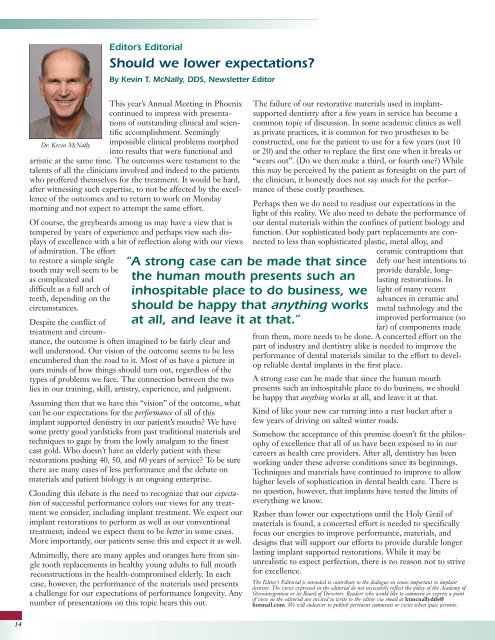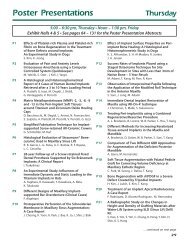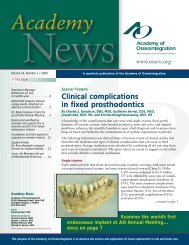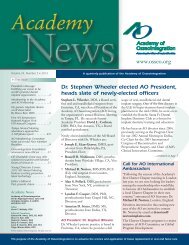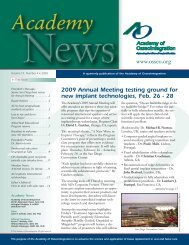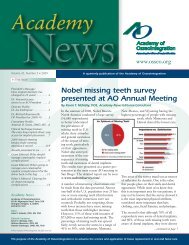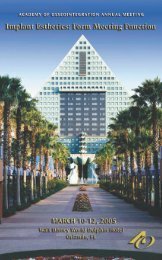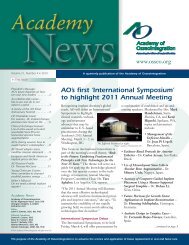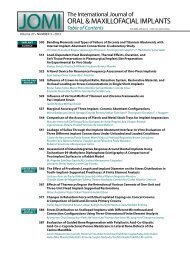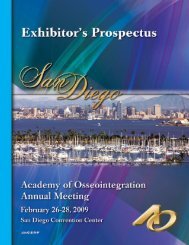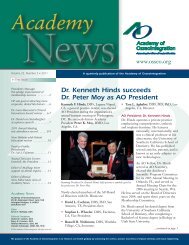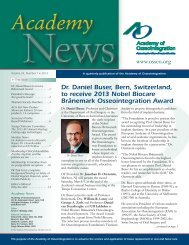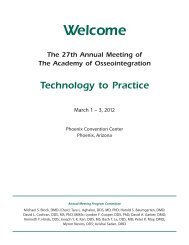Fellows - Academy of Osseointegration
Fellows - Academy of Osseointegration
Fellows - Academy of Osseointegration
You also want an ePaper? Increase the reach of your titles
YUMPU automatically turns print PDFs into web optimized ePapers that Google loves.
Editor’s Editorial<br />
Should we lower expectations?<br />
By Kevin T. McNally, DDS, Newsletter Editor<br />
This year’s Annual Meeting in Phoenix<br />
continued to impress with presentations<br />
<strong>of</strong> outstanding clinical and scientific<br />
accomplishment. Seemingly<br />
Dr. Kevin McNally impossible clinical problems morphed<br />
into results that were functional and<br />
artistic at the same time. The outcomes were testament to the<br />
talents <strong>of</strong> all the clinicians involved and indeed to the patients<br />
who pr<strong>of</strong>fered themselves for the treatment. It would be hard,<br />
after witnessing such expertise, to not be affected by the excellence<br />
<strong>of</strong> the outcomes and to return to work on Monday<br />
morning and not expect to attempt the same effort.<br />
Of course, the greybeards among us may have a view that is<br />
tempered by years <strong>of</strong> experience and perhaps view such displays<br />
<strong>of</strong> excellence with a bit <strong>of</strong> reflection along with our views<br />
<strong>of</strong> admiration. The effort<br />
to restore a simple single<br />
tooth may well seem to be<br />
as complicated and<br />
difficult as a full arch <strong>of</strong><br />
teeth, depending on the<br />
circumstances.<br />
Despite the conflict <strong>of</strong><br />
treatment and circumstance,<br />
the outcome is <strong>of</strong>ten imagined to be fairly clear and<br />
well understood. Our vision <strong>of</strong> the outcome seems to be less<br />
encumbered than the road to it. Most <strong>of</strong> us have a picture in<br />
ours minds <strong>of</strong> how things should turn out, regardless <strong>of</strong> the<br />
types <strong>of</strong> problems we face. The connection between the two<br />
lies in our training, skill, artistry, experience, and judgment.<br />
Assuming then that we have this “vision” <strong>of</strong> the outcome, what<br />
can be our expectations for the performance <strong>of</strong> all <strong>of</strong> this<br />
implant supported dentistry in our patient’s mouths? We have<br />
some pretty good yardsticks from past traditional materials and<br />
techniques to gage by from the lowly amalgam to the finest<br />
cast gold. Who doesn’t have an elderly patient with these<br />
restorations pushing 40, 50, and 60 years <strong>of</strong> service? To be sure<br />
there are many cases <strong>of</strong> less performance and the debate on<br />
materials and patient biology is an ongoing enterprise.<br />
Clouding this debate is the need to recognize that our expectation<br />
<strong>of</strong> successful performance colors our views for any treatment<br />
we consider, including implant treatment. We expect our<br />
implant restorations to perform as well as our conventional<br />
treatment; indeed we expect them to be better in some cases.<br />
More importantly, our patients sense this and expect it as well.<br />
Admittedly, there are many apples and oranges here from single<br />
tooth replacements in healthy young adults to full mouth<br />
reconstructions in the health-compromised elderly. In each<br />
case, however, the performance <strong>of</strong> the materials used presents<br />
a challenge for our expectations <strong>of</strong> performance longevity. Any<br />
number <strong>of</strong> presentations on this topic bears this out.<br />
The failure <strong>of</strong> our restorative materials used in implantsupported<br />
dentistry after a few years in service has become a<br />
common topic <strong>of</strong> discussion. In some academic clinics as well<br />
as private practices, it is common for two prostheses to be<br />
constructed, one for the patient to use for a few years (not 10<br />
or 20) and the other to replace the first one when it breaks or<br />
“wears out”. (Do we then make a third, or fourth one?) While<br />
this may be perceived by the patient as foresight on the part <strong>of</strong><br />
the clinician, it honestly does not say much for the performance<br />
<strong>of</strong> these costly prostheses.<br />
Perhaps then we do need to readjust our expectations in the<br />
light <strong>of</strong> this reality. We also need to debate the performance <strong>of</strong><br />
our dental materials within the confines <strong>of</strong> patient biology and<br />
function. Our sophisticated body part replacements are connected<br />
to less than sophisticated plastic, metal alloy, and<br />
ceramic contraptions that<br />
“A strong case can be made that since<br />
the human mouth presents such an<br />
inhospitable place to do business, we<br />
should be happy that anything works<br />
at all, and leave it at that.”<br />
defy our best intentions to<br />
provide durable, longlasting<br />
restorations. In<br />
light <strong>of</strong> many recent<br />
advances in ceramic and<br />
metal technology and the<br />
improved performance (so<br />
far) <strong>of</strong> components made<br />
from them, more needs to be done. A concerted effort on the<br />
part <strong>of</strong> industry and dentistry alike is needed to improve the<br />
performance <strong>of</strong> dental materials similar to the effort to develop<br />
reliable dental implants in the first place.<br />
A strong case can be made that since the human mouth<br />
presents such an inhospitable place to do business, we should<br />
be happy that anything works at all, and leave it at that.<br />
Kind <strong>of</strong> like your new car turning into a rust bucket after a<br />
few years <strong>of</strong> driving on salted winter roads.<br />
Somehow the acceptance <strong>of</strong> this premise doesn’t fit the philosophy<br />
<strong>of</strong> excellence that all <strong>of</strong> us have been exposed to in our<br />
careers as health care providers. After all, dentistry has been<br />
working under these adverse conditions since its beginnings.<br />
Techniques and materials have continued to improve to allow<br />
higher levels <strong>of</strong> sophistication in dental health care. There is<br />
no question, however, that implants have tested the limits <strong>of</strong><br />
everything we know.<br />
Rather than lower our expectations until the Holy Grail <strong>of</strong><br />
materials is found, a concerted effort is needed to specifically<br />
focus our energies to improve performance, materials, and<br />
designs that will support our efforts to provide durable longer<br />
lasting implant supported restorations. While it may be<br />
unrealistic to expect perfection, there is no reason not to strive<br />
for excellence.<br />
The Editor’s Editorial is intended to contribute to the dialogue on issues important to implant<br />
dentists. The views expressed in the editorial do not necessarily reflect the policy <strong>of</strong> the <strong>Academy</strong> <strong>of</strong><br />
<strong>Osseointegration</strong> or its Board <strong>of</strong> Directors. Readers who would like to comment or express a point<br />
<strong>of</strong> view on the editorial are invited to write to the editor via email at ktmcnallydds@<br />
hotmail.com. We will endeavor to publish pertinent comments or views when space permits.<br />
14


